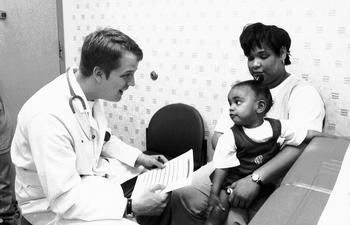Screening tool aids in childhood disability diagnosis

Dr. Chris Morton examines one-year-old Kristin Johnson, sitting in the lap of her mother, Kebbyn. (Photo by Donna Jones Bailey).
A Vanderbilt Children¹s Hospital researcher has developed a screening tool to help health care providers quickly and easily identify children with developmental disabilities or delays during the important pre-school years when early intervention can make the most difference.
The tool, which includes a short questionnaire for parents and a guide for interpreting the results, is based on more than 10 years of peer-reviewed research that has found that certain parental concerns at certain ages are predictors of developmental and behavioral problems.
"My research began with the question, ŒShould we be paying attention to parents¹ concerns about their child¹s development?¹ I¹ve found that some of their concerns are important in predicting which children are at risk for disabilities or delays, and which are not," said Frances P. Glascoe, Ph.D., associate professor of Pediatrics. "Over the years, I¹ve collected data from about 1,000 children across the country, and I realized that I had basically standardized and validated a measure."
Working with a Nashville-based publisher, Glascoe has now published the screening tool, called Parents¹ Evaluation of Developmental Status (PEDS), which pediatricians across the country are beginning to use in their practices.
PEDS is 70 percent to 80 percent accurate in identifying children with disabilities and can be administered by a wide range of health care professionals or office staff, said Glascoe, a member of the Child Development Center and an investigator in the John F. Kennedy Center.
More than half of children with serious developmental and behavioral problems are not identified before they enter school. The subtle and emerging nature of children¹s delays make early detection challenging, Glascoe said. To add to the challenge, parents often voice a number of concerns during their pediatric visits ‹ some important, others not ‹ or parents with legitimate concerns may fail to raise them.
PEDS helps providers elicit and interpret parental concerns. The system assigns probabilities of delays and disabilities to the various kinds of concerns, allowing providers to make evidence-based decisions about whether to refer for further evaluation, provide screening and vigilant observation, or counsel parents in the office.
To use PEDS, parents answer 10 questions ‹ written at the fifth-grade level in English or Spanish ‹ often while waiting for their appointment. Scoring and interpretation of the results takes only about two minutes, Glascoe said.
"Having parents complete PEDS before their encounter with the provider gives them an opportunity to think more clearly about what might be wrong and to express themselves completely, without taking up a lot of provider time," she said. "At the same time, PEDS allows the provider to view and give appropriate weight to parents¹ concerns and have an opportunity to more clearly think about what needs to happen next."
The system is designed to be used at the recommended well-child examinations from birth through age 8, and costs only about 35 cents per patient encounter if used across that age range, Glascoe said.
"It costs less than $5 to screen a child from birth through age 8," she said. "And it¹s a real collaborative effort on the part of the provider and the parents. It says to the parent, ŒYour concerns are important.¹ That¹s a valuable message."
To interpret the results, parents¹ concerns are recorded on a score form, with significant concerns recorded in shaded areas of the form. The provider totals the number of concerns that fall in the shaded areas and then follows a flow chart based on the number of significant concerns voiced by the parent.
"It¹s all based on likelihood," Glascoe said. "Providers can look at the form and know that two or more significant concerns pose 20 times the risk of disability, one concern represents seven times the risk and no concerns represents no increased risk."
However, the experience and professional judgment of the provider is critical to effectively use PEDS, Glascoe said.
"It¹s a tool that can help physicians use their expertise and what they know about the patient, the family and their history to make a decision based on the likelihood of problems," Glascoe said.













